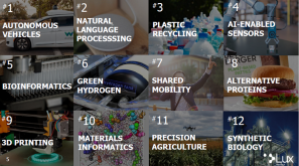Autonomous vehicles top Lux Research’s annual top ranking of key technologies that will have the biggest impact over the next 10 years. The scores for the emerging tech trends are based on the Lux Tech Signal, a measure created from a variety of innovation data sources, together with insight from Lux’s analysts.
The report, “Foresight 2021: Top Emerging Technologies to Watch,” ranks 12 key technologies, each with a look at a case study and key megatrends. In addition, for the first time the report ranks the top five technologies across five key industries: chemicals and materials, automotive, food and agriculture, electronics and IT and energy.
Each of the 12 top emerging technologies feature an overview, a case study, and a view into driving megatrends. Here are five of the top emerging tech trends for 2021. For more information, visit here.
Autonomous vehicles: Lux analysts report that improvements in safety and efficiency are happening at all levels of vehicle automation, with Level 4 and 5 autonomous vehicles transforming mobility and logistics by removing the need for a driver.
Natural language processing: Powering devices like voice assistants, machine translation, and chatbots, natural language processing (NLP) patents tallied a 44% compound annual growth rate over the past five years, according to Lux Research.
Plastic recycling: Major consumer product companies have made commitments to increasing recycling rates and innovations that can convert waste into higher-value products, reported Lux, and over the past decade 155 startups have been found to address plastic waste,
AI-enabled sensors: Advances in machine learning capabilities enable users to extract more value out of sensors, said Lux, and open up opportunities to create new products and improve internal processes by gain new insights from existing hardware.
Bioinformatics: Although the largest use of bioinformatics is in pharmaceutical discovery, according to a recent Lux report, it offers new opportunities such as in risk management, safety, personalization, diagnostics, and traceability, impacting a range of industries, including food and agriculture.
Technologies ranked from six to 12 are: green hydrogen, shared mobility, alternative proteins, 3D printing, materials informatics, precision agriculture, and synthetic biology.
Interestingly ten of last year’s 20 technologies don’t appear on this year’s lists. Most notable, said Lux, is 5G networks, which claimed the top spot in last year’s report. This could indicate that 5G is firmly established in the industry.
The report also finds that some of these technologies, including digital biomarkers and AI-enabled sensors, will help get businesses back to work. “But for all the changes that the pandemic has brought, the key megatrends shaping the future are still in force,” said Michael Holman, Ph.D., vice president of research and lead author of the report. “Technologies that support these transitions, such as autonomous vehicles, alternative proteins, and green hydrogen, will maintain their momentum as a result.”
Advertisement
Learn more about Lux Research






